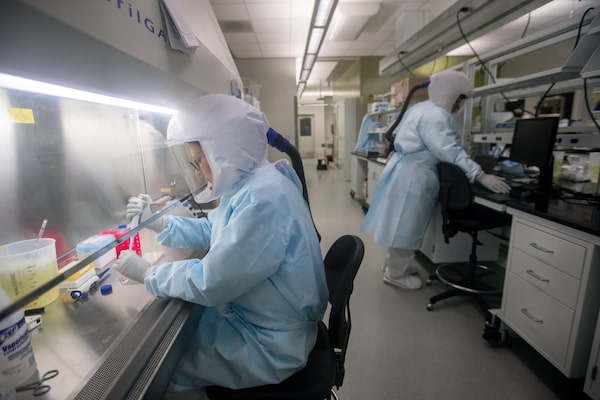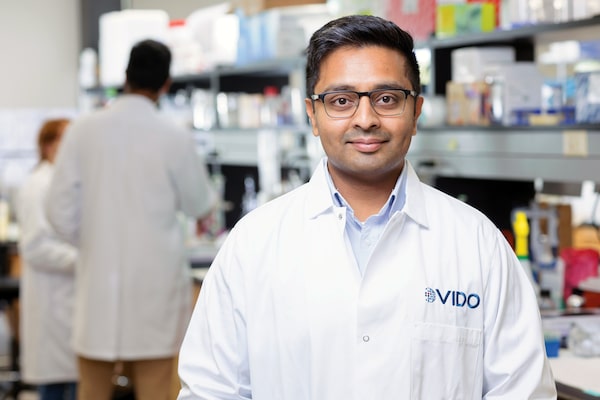
Research scientists studying infectious diseases, working with infrastructure that is rare in the world at the Vaccine and Infectious Disease Organization (VIDO) at the University of Saskatchewan.supplied
It seems easier to count lives that have been lost than to calculate those that have been saved. Yet in consideration of the deathly toll of infectious diseases like polio, smallpox or influenza – and the subsequent success in mitigating their impact through immunizations – the World Health Organization estimates that vaccinations save about two million to three million lives annually.
“Vaccines are hands down one of humankind’s greatest discoveries,” says Arinjay Banerjee, principal investigator, Vaccine and Infectious Disease Organization (VIDO), University of Saskatchewan (USask). “With modern medicine – including vaccines and drugs – we have managed to increase the human lifespan beyond what was imaginable, even during my grandparents’ lifetime.”
Immunization efforts have recently come to the forefront due to the coronavirus pandemic, which inspired a global effort to bring “vaccines to people faster than ever before,” says Dr. Banerjee. “But it’s critical to understand that this technology was not discovered overnight. Decades of research, for example, on mRNA vaccine design and safety, enabled the development of a vaccine in about a year.”
Still, more than six million people died from COVID-19, and Dr. Banerjee suggests we can shorten response times “by proactively preparing vaccine candidates for potential future threats.”
VIDO’s track record of ‘firsts’
Infectious diseases are part of our past and present as well as our future, believes Volker Gerdts, VIDO’s director and CEO. “Around the world, we are coming into closer contact with animals,” he says. “We are encroaching on their habitats, and this means there is a greater chance of seeing events like the current coronavirus pandemic if the diseases originate in animals.”
The work at VIDO, a national centre that receives funding support from the Canada Foundation for Innovation Major Science Initiatives and the Government of Saskatchewan, has long been focused on mustering a rapid response to emerging human and animal diseases. VIDO’s team was the first to isolate the SARS-CoV-2 virus from the first Canadian case in collaboration with Sunnybrook and Canada’s National Microbiology Laboratory (NML).

Dr. Arinjay Banerjee.supplied
“We were also the first to establish an animal model of coronavirus infection,” he says. “And for a time, we were among the world’s fastest in developing a vaccine candidate.” This subunit vaccine, which contains purified viral proteins, is currently being tested in clinical trials in Africa – and will potentially be considered as a booster in Canada.
“The current pandemic has made it clear that many parts of our planet do not have ready access to vaccines and boosters,” says Baljit Singh, vice-president, Research, USask. “We are proud of VIDO’s work in this area, which will help ensure the health and security of people across the globe.”
The impressive range of achievements at VIDO bolstered USask’s national and international reputation for cutting-edge research infrastructure and expertise – it also allowed scientists to pivot rapidly to study COVID-19.
Learning from the way bats co-exist with coronaviruses
An estimated 60 per cent of known infectious diseases and up to 75 per cent of new or emerging pathogens are zoonotic in origin, i.e. are transmitted between animals and humans. Such threats, among which coronaviruses play a prominent role, have been the focus of VIDO’s Zoonotic Viruses and Comparative Immunology research, led by Dr. Banerjee.
Out of three themes within his research program, the first examines how viruses interact with their animal reservoir hosts, such as bats, for example, he says. “The second theme looks at what happens when viruses make the jump from reservoir hosts to humans.”
VIDO has a wide range of expertise and operates in some of the world’s best research infrastructure at USask, a campus comprising 17 colleges and schools.
— Dr. Volker Gerdts, Director and CEO of the University of Saskatchewan’s Vaccine and Infectious Disease Organization (VIDO)
Coronaviruses can effectively block the immune response of human cells – and even induce a detrimental inflammatory response, according to Dr. Banerjee. “Many of the symptoms that patients with highly pathogenic coronavirus infections experience are driven by inflammation, and inflammation that goes out of control can cause severe disease,” he explains. “However, our research shows that bats with coronaviruses don’t experience such severe inflammation.”
Insights into how animals like bats manage to co-exist with coronaviruses can potentially help address such infections in humans, proposes Dr. Banerjee, and the third theme’s mandate is to translate scientific findings into medical interventions – for SARS-CoV-2 as well as other emerging infectious diseases.
The goal is to “identify potential threats – and have a catalogue of potential therapeutics and vaccines in the pipeline,” he says. “This means that when there’s an outbreak, when a virus makes the jump from another species to humans, we can quickly ramp up production.”
Strengthening Canada’s rapid response capabilities
Since Dr. Banerjee and his colleagues conduct research on highly pathogenic viruses and rely on animal models, they require access to specialized containment labs that are rare in the world, and VIDO has one of the largest, most advanced of these labs globally.
“VIDO has a wide range of expertise and operates in some of the world’s best research infrastructure at USask, a campus comprising 17 colleges and schools. This makes it one of the most comprehensive institutions for advancing ‘one health’ – which promotes better outcomes for both humans and animals,” says Dr. Gerdts, who adds that this has helped to attract a range of partners from government, academia and industry.

Dr. Volker Gerdts.supplied
“Through COVID-19, we worked with more than 100 companies to test their technologies, whether that’s vaccines, anti-viral compounds or therapeutics, in addition to developing our own COVID-19 vaccine,” he explains. While there have been many examples of VIDO creating game-changing technologies, the experiences of the past two years have also illustrated the need to build additional capacity – not only for stepping up research activity but for translating findings into tangible impact.
To that end, VIDO has secured funding support to “enhance our capabilities as Canada’s Centre for Pandemic Research – and to establish an in-house vaccine manufacturing facility, scheduled to finish construction this year,” he says. “We will also upgrade key areas of our level 3 biosafety lab to containment level 4.”
This will effectively double Canada’s capacity for researching the most severe and contagious diseases, since the only other level 4 facility is the NML in Winnipeg, explains Dr. Gerdts. “Level 4 diseases, Nipah and Lassa fever among them, currently have high priority, not only for the Canadian government but for global entities like the World Health Organization and the Coalition for Epidemic Preparedness Innovations.”
The added capacity will allow Canada to be more self-sufficient “in responding to COVID-19 as well as emerging diseases,” he says. “VIDO will play a key role in pandemic preparedness.”
Dr. Banerjee agrees. “[VIDO] will be the place to study not just COVID-19 but any disease that may show up,” he says. “By investing in vaccines for future threats, we can hopefully shorten the time between conceptualizing a vaccine, manufacturing it and then getting it into the arms of the people who need it.”
Dr. Singh adds, “At USask, researchers are working hard today with the future in mind.”
Advertising feature produced by Randall Anthony Communications. The Globe’s editorial department was not involved.